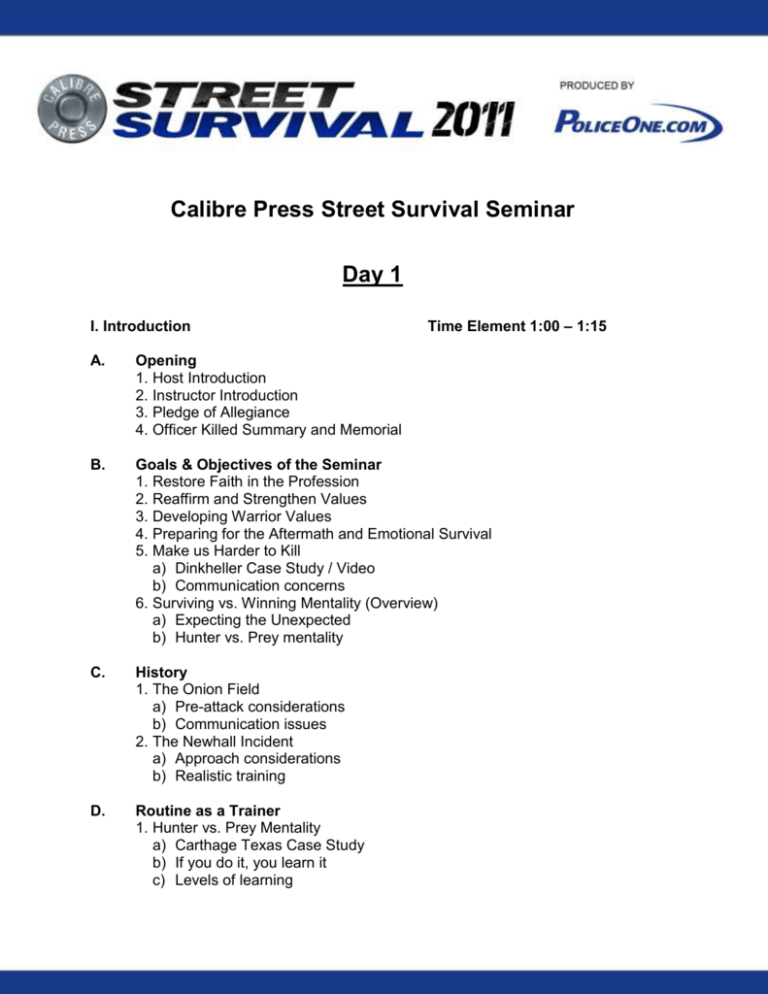Dave,
advertisement

Calibre Press Street Survival Seminar Day 1 I. Introduction Time Element 1:00 – 1:15 A. Opening 1. Host Introduction 2. Instructor Introduction 3. Pledge of Allegiance 4. Officer Killed Summary and Memorial B. Goals & Objectives of the Seminar 1. Restore Faith in the Profession 2. Reaffirm and Strengthen Values 3. Developing Warrior Values 4. Preparing for the Aftermath and Emotional Survival 5. Make us Harder to Kill a) Dinkheller Case Study / Video b) Communication concerns 6. Surviving vs. Winning Mentality (Overview) a) Expecting the Unexpected b) Hunter vs. Prey mentality C. History 1. The Onion Field a) Pre-attack considerations b) Communication issues 2. The Newhall Incident a) Approach considerations b) Realistic training D. Routine as a Trainer 1. Hunter vs. Prey Mentality a) Carthage Texas Case Study b) If you do it, you learn it c) Levels of learning 1 Objectives: Discuss the lessons learned from officers killed and injured Explore the legacy of survival on the street Learn how to plan and execute your personal and professional goals Understand and learn from law enforcement history Accept the reality of Routine and how it pertains to surviving violent confrontations II. The Winning Mind Time Element 1:00 – 1:15 A. Winning vs. Surviving 1. Personally 2. Organizationally a) Line Level Survey b) Organizational Culture and Officer Safety 3. Learning from Mistakes a) Augusta, GA Case Study / Video b) Mental Preparation c) Physical Preparedness B. The 5%er Mindset 1. 12 Characteristics of the 5%er Mentality a) Based on Analysis of the Mindset of Ultimate Survivors and Featured in the book, Street Survival: Tactics for Armed Encounters b) Case Studies and Videos 2. When / Then Thinking a) The Reality of Prejudice b) Learning to Trust Your Instincts c) Cop Kinetics d) Reading People e) Case Studies and Videos Objectives: Uncover and discuss the difference between physical survival and the complete winning mentality Review numerous case studies and videos reference the 5%er mindset Discuss the When / Then thinking perspective Introduce the powerful impact of perspective and total communication while employed in the field of criminal justice 2 III. Control Process Time Element 1:00 - 1:10 A. Our Goal - Control 1. In order to control others, officers must be able to control the self 2. Approach Considerations 3. Utah Traffic Stop Case Study / Video B. Mental Preparation 1. Checking our Minds a) Mental Awareness Color Coded System i. Condition White ii. The Cobra iii. Condition Yellow iv. Condition Orange v. Condition Red vi. Condition Black vii. Presumed Compliance viii. Numerous Case Studies / Video Clips 2. Checking our Bodies a) FBI Studies b) Image and Perception 3. Checking our Spirits a) Contact / Cover Principles b) Pre-Attack Indicators i. Body Language ii. Verbal Cues C. Single Officer Decision Making 1. Case Study / Video a) Approach considerations b) Back-up options c) disengaging Objectives: List the mental and physical aspects of control Learn how to gain a position of advantage Learn the importance of appearance as crucial to winning List and describe non-verbal communication Properly using cover and contact Discuss what are you willing to do to stay alive Numerous Videos / Case Studies 3 IV. CRIMINAL PATROL A. Unknown Risk Encounters 1. Videos 2. Case Studies B. High Risk Encounters 1. Videos & Case Studies 2. Special Problems 3. Inherent Dangers C. Unusual Threats / Encounters 1. Dialogue Cues a) Non-verbal indicators b) Verbal indicators 2. Suspicious Mannerisms a) Body language b) Scanning c) Watching the eyes D. Survival Mindset 1. Trooper Coates Case Study / Video 2. Search Commandments a) back-up before search b) secure suspect before search Time Element 1:00 – 1:10 Objectives: Discuss the issues confronting law enforcement officers when encountering suspects during any enforcement activity Learn the key tactical positions and strategies to reduce chance of assault Identify the most likely concealment points on persons and vehicles Learn how to reduce risks by understanding communication techniques V. Off Duty Survival A. Time Element 1:00 – 1:10 Understanding the Reality of Off-Duty Behavior 1. Off-Duty for those in plain clothes? 2. Mindset for on and off-duty 4 B. Discussion of the Most Common Causes of Off-Duty Deaths 1. Off-Duty checklist a) Stacy Limm Case Study / Video b) Tony Luketic Case Study c) Dayton Ohio Case Study 2. Environmental Factors a) McDonalds Shooting Case Study b) Involvement considerations C. Training for the off-duty encounter D. Equipment issues for off duty threats E. Identification and Responding Officers 1. How to identify yourself 2. “Uniforms trump plainclothes” 3. Communication F. The Decision to Get Involved 1. Intervention Assessment a) Non-Critical b) Important but not critical c) Critical G. Preparing your family for the off duty encounter 1. Communication a) Pre-event planning b) Body language cues c) Calming techniques 2. Concealment vs. cover 3. Contacting and communicating with Dispatch Objectives: Learn how to mentally and physically prepare for an off duty encounter List and discuss the responsibilities to yourself and others Determine what action to take: intervention or observation Discuss the protection and education of your family Learn how to relate to responding officers 5 VI. Peak Performance Time Element 1:00 – 1:10 A. Attaining and Maintaining a Mentality of Peak Performance 1. Winning Goals 2. Conditions of Practice 3. Video / Case Study B. Beliefs: The Foundation of Peak Performance 1. Internal and External Belief systems 2. Beliefs Systems and Adversity 3. Faith and Performance 4. Maintaining Your Distance C. Peak Performance in Combat Situations 1. Heart Rate a) Performance Deterioration b) SNS Response D. Physiology of Performance 1. Nutrition 2. Exercise a) Cardio b) Anaerobic 3. Physical Commitment a) Mind/Body Connection b) Autogenic Breathing c) Focus Control E. Psychology of Performance 1. Crisis Rehearsal 2. Controlling Fear Objectives: Explore the mind/body connection and learn how to enhance physical performance and control emotional response Learn how to train the mind through crisis rehearsal Discuss reinforcing your faiths Learn how to train the body through levels of physical development Learn how to control fear and arousal Review and understand the energy of success 6 Day 2 VII. Tactical Edge A. Understanding the Tactical Edge 1. Gaining and Maintaining the Edge 2. Increasing Awareness B. Awareness – Personal Preparation 1. Puerto Rico – Case Study / Video 2. Communication issues 3. Body language C. The Thought Process of Criminals 1. Tactical thinking 2. Weapons Awareness 3. What threat are we facing? 4. Case Studies / Videos 5. Thinking in the reality 6. Threat considerations Time Element 1:00 – 1:10 Objectives: Gaining the and maintaining the mental edge List and discuss tactical responses and applications Learn how to gain and keep physical control The importance of body language cues VIII. Terrorism (Battling the War in America’s Heartland) A. Defining and Understanding Terrorism 1. Domestic & International Terrorism 2. Terrorist Motivations 3. The violent true believer 4. Case Studies B. Domestic Terrorism 1. Case Studies 2. Domestic Motivations Time Element 1:00 – 1:10 7 3. Local Law Enforcement Response C. Radical Islamism 1. Understanding Islam 2. Understanding Radical Islamism 3. U.S. Case Study D. The U.S. and Radical Islamism 1. How long has the U.S. been dealing with Radical Islamism 2. What we face today as a nation 3. Law enforcement perspective on a global scale 4. Law enforcement perspective on a local scale 5. Jihad in America E. Terrorist Targets / Weapons 1. Biological Agents 2. Nuclear Devices 3. Incendiary Devices 4. Chemical Agents 5. Explosive Devices F. What We Can Expect Objectives: Identify and understand the motives of terrorists List and review the patrol tactics to deter terrorism Learn how to maintain the “hunter” mindset Learn how to locate your regional risks Discuss gathering intelligence for prevention IX. Emotional Survival A. Realities of Law Enforcement Work 1. Why become a cop? 2. Paradigm shifts 3. Cynicism 4. Victim Based Thinking 5. Our goal - control B. The Law Enforcement Paradox 1. Work behavior vs. Home behavior Time Element 1:00 – 1:10 8 2. 3. 4. 5. C. The “Magic Chair” Taking and Giving Orders The danger of the “hyper vigilance rollercoaster” Control what you can, not what you can’t Developing Coping Skills 1. Attitude 2. Coping 3. Critical Incidents Objectives: Learn ways to cope with stress and career disappointments Taking control of your life Learn to become a better spouse, parent, partner, friend Surviving and thriving in your chosen career X. Surviving Edge Weapons Time Element 1:00 – 1:10 A. Mental Preparation 1. Understanding realistic options 2. Reality based training B. Edged Weapons - Definition 1. Stabbing 2. Slashing 3. Photos 4. Case Studies 5. Weapons awareness/weapons alert 6. Tactical considerations to win the edged weapon assault C. Distance 1. 21 Foot Rule? 2. The reality of distance and edged weapon threats 3. Maintaining escape routes D. The Hierarchy of Deadliness 1. Proper response 2. Deadly force options E. Controlling and Utilizing Our Equipment 1. Knives 2. Handcuffs 9 3. Pens 4. Body Armor Objectives: List weapons of opportunity and their deadly effects Explain why "21" is not enough Understand and learn how to apply the required use of force Discuss mental preparation XI. Less Than Lethal Force G. Legal Realities of Using Force 1. Excessive vs. Acceptable Force 2. Case Studies / Videos 3. Graham vs. Connor B. Factors to Consider in the Totality 1. How did the relationship begin 2. Variables a) Demonstration 3. Level of resistance encountered 4. Special circumstances 5. Environmental concerns 6. Force Continuum 7. Documentation C. Less Than Lethal Options 1. Officer Presence 2. Verbal commands 3. Empty Hand 4. Intermediate Weapons a) OC b) Impact Weapon 5. Taser Time Element 1:00 – 1:10 Objectives: Discuss weapons and tactics available today Choosing the proper weapon and tactic for each encounter Understand weapons transitioning 10 XII. Deadly Force Time Element 1:00 – 1:10 A. The Reality of Deadly force 1. Videos / Case Studies 2. Discussion on preparation to use deadly force B. Physics of winning confrontations 1. Should you shoot to kill? 2. Center mass 3. Ammunition 4. Wound creation 5. Head shots C. Preventing Unintentional Discharges 1. Involuntary muscle contractions a) Startle response b) Balance disturbance c) Interlimb interaction 2. Training D. One Shot Stopping 1. Contact shots 2. Case Study – Miami Firefight 3. Videos E. Follow Through Considerations 1. Case Study – Dillman 2. Case Study – Fulford 3. Calibre Rules for Deadly Force Encounters F. Closing Objectives: Review mental attitude to win at all costs Explain the differences between spontaneous and non-spontaneous encounters Discuss the concept of marksmanship versus combat Learn how to fight with a firearm Discuss what the statistics say Learn how to neutralize a deadly attack without hesitation 11






